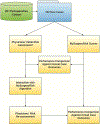Comparing clinical judgment with the MySurgeryRisk algorithm for preoperative risk assessment: A pilot usability study
- PMID: 30792011
- PMCID: PMC6502657
- DOI: 10.1016/j.surg.2019.01.002
Comparing clinical judgment with the MySurgeryRisk algorithm for preoperative risk assessment: A pilot usability study
Abstract
Background: Major postoperative complications are associated with increased cost and mortality. The complexity of electronic health records overwhelms physicians' abilities to use the information for optimal and timely preoperative risk assessment. We hypothesized that data-driven, predictive-risk algorithms implemented in an intelligent decision-support platform simplify and augment physicians' risk assessments.
Methods: This prospective, nonrandomized pilot study of 20 physicians at a quaternary academic medical center compared the usability and accuracy of preoperative risk assessment between physicians and MySurgeryRisk, a validated, machine-learning algorithm, using a simulated workflow for the real-time, intelligent decision-support platform. We used area under the receiver operating characteristic curve to compare the accuracy of physicians' risk assessment for six postoperative complications before and after interaction with the algorithm for 150 clinical cases.
Results: The area under the receiver operating characteristic curve of the MySurgeryRisk algorithm ranged between 0.73 and 0.85 and was significantly better than physicians' initial risk assessments (area under the receiver operating characteristic curve between 0.47 and 0.69) for all postoperative complications except cardiovascular. After interaction with the algorithm, the physicians significantly improved their risk assessment for acute kidney injury and for an intensive care unit admission greater than 48 hours, resulting in a net improvement of reclassification of 12% and 16%, respectively. Physicians rated the algorithm as easy to use and useful.
Conclusion: Implementation of a validated, MySurgeryRisk computational algorithm for real-time predictive analytics with data derived from the electronic health records to augment physicians' decision-making is feasible and accepted by physicians. Early involvement of physicians as key stakeholders in both design and implementation of this technology will be crucial for its future success.
Copyright © 2019 Elsevier Inc. All rights reserved.
Conflict of interest statement
Figures





Similar articles
-
MySurgeryRisk: Development and Validation of a Machine-learning Risk Algorithm for Major Complications and Death After Surgery.Ann Surg. 2019 Apr;269(4):652-662. doi: 10.1097/SLA.0000000000002706. Ann Surg. 2019. PMID: 29489489 Free PMC article.
-
Performance of a Machine Learning Algorithm Using Electronic Health Record Data to Predict Postoperative Complications and Report on a Mobile Platform.JAMA Netw Open. 2022 May 2;5(5):e2211973. doi: 10.1001/jamanetworkopen.2022.11973. JAMA Netw Open. 2022. PMID: 35576007 Free PMC article.
-
Optimizing predictive strategies for acute kidney injury after major vascular surgery.Surgery. 2021 Jul;170(1):298-303. doi: 10.1016/j.surg.2021.01.030. Epub 2021 Feb 27. Surgery. 2021. PMID: 33648766 Free PMC article.
-
Machine Learning and Surgical Outcomes Prediction: A Systematic Review.J Surg Res. 2021 Aug;264:346-361. doi: 10.1016/j.jss.2021.02.045. Epub 2021 Apr 10. J Surg Res. 2021. PMID: 33848833
-
Pediatric Surgical Risk Assessment Tools: A Systematic Review.J Surg Res. 2019 Feb;234:277-282. doi: 10.1016/j.jss.2018.09.051. Epub 2018 Oct 23. J Surg Res. 2019. PMID: 30527485
Cited by
-
Effect of Machine Learning on Anaesthesiology Clinician Prediction of Postoperative Complications: The Perioperative ORACLE Randomised Clinical Trial.medRxiv [Preprint]. 2024 May 23:2024.05.22.24307754. doi: 10.1101/2024.05.22.24307754. medRxiv. 2024. Update in: Br J Anaesth. 2024 Nov;133(5):1042-1050. doi: 10.1016/j.bja.2024.08.004. PMID: 38826471 Free PMC article. Updated. Preprint.
-
The Importance of Incorporating Human Factors in the Design and Implementation of Artificial Intelligence for Skin Cancer Diagnosis in the Real World.Am J Clin Dermatol. 2021 Mar;22(2):233-242. doi: 10.1007/s40257-020-00574-4. Am J Clin Dermatol. 2021. PMID: 33354741 Review.
-
Prospective Human Validation of Artificial Intelligence Interventions in Cardiology: A Scoping Review.JACC Adv. 2024 Aug 28;3(9):101202. doi: 10.1016/j.jacadv.2024.101202. eCollection 2024 Sep. JACC Adv. 2024. PMID: 39372457 Free PMC article.
-
Personalized decision-making for acute cholecystitis: Understanding surgeon judgment.Front Digit Health. 2022 Sep 15;4:845453. doi: 10.3389/fdgth.2022.845453. eCollection 2022. Front Digit Health. 2022. PMID: 36339515 Free PMC article.
-
Perspectives toward the application of Artificial Intelligence in anesthesiology-related practices in Saudi Arabia: A cross-sectional study of physicians views.Health Sci Rep. 2024 Oct 14;7(10):e70099. doi: 10.1002/hsr2.70099. eCollection 2024 Oct. Health Sci Rep. 2024. PMID: 39410950 Free PMC article.
References
-
- Tepas JJ, Rimar JM, Hsiao AL, Nussbaum MS. Automated analysis of electronic medical record data reflects the pathophysiology of operative complications. Surgery. 2013;154:918–24. - PubMed
-
- Lagu T, Rothberg MB, Shieh MS, Pekow PS, Steingrub JS, Lindenauer PK. Hospitalizations, costs, and outcomes of severe sepsis in the United States 2003 to 2007. Crit Care Med. 2012;40:754–61. - PubMed
-
- Silber JH, Rosenbaum PR, Trudeau ME, Chen W, Zhang X, Kelz RR, et al. Changes in prognosis after the first postoperative complication. Med Care. 2005;43:122–31. - PubMed
Publication types
MeSH terms
Grants and funding
LinkOut - more resources
Full Text Sources

